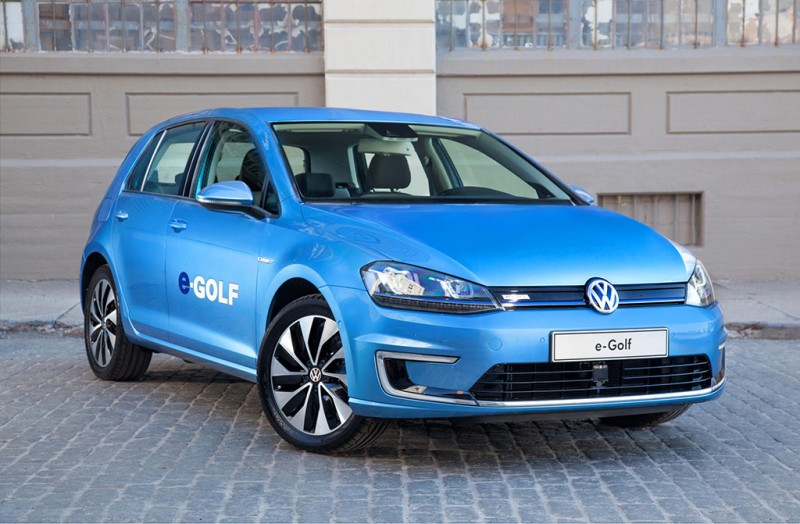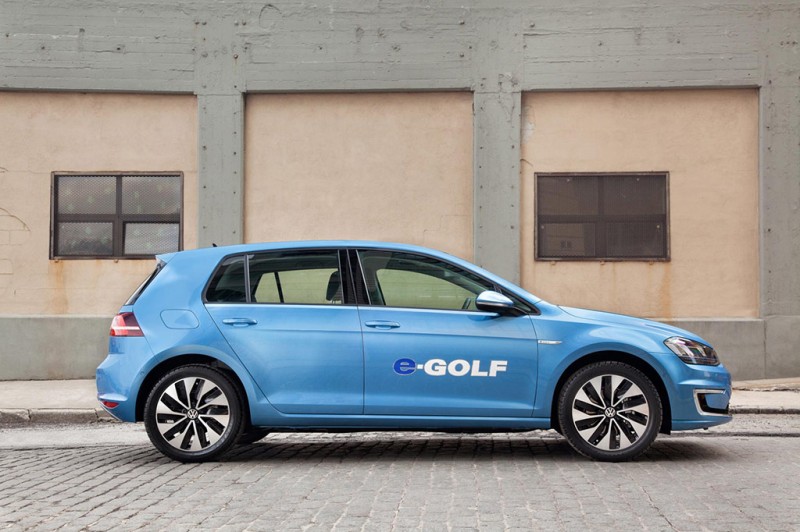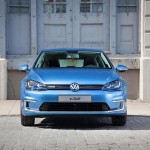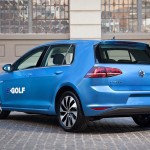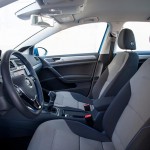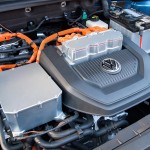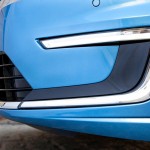The 2015 e-Golf is Volkswagen’s first fully electric vehicle for the U.S., due to go on sale in select states in the fourth quarter of 2014. The all-new model is part of a structured powertrain strategy that will lead to the introduction of new and highly efficient drive systems, and is part of Volkswagen’s holistic approach to sustainability called Think Blue®. Volkswagen has stated that it aims to be the world leader in e-mobility among automakers by 2018.
Although Volkswagen has sold more than 30 million Golf models worldwide, this is the first model sold that produces zero tailpipe emissions and operates fully on electric power. The e-Golf is available in four-door form only and is immediately recognizable by its unique aluminum-alloy wheels and LED headlights, the first VW to be equipped with the technology in the U.S.-market. The LED headlights are more energy-efficient than Bi-Xenon systems, yet produce more light. Featuring a signature C-shaped design, the highly efficient LED daytime running lights are a distinguishing feature of all Volkswagen electric vehicles and come standard on the e-Golf. Another striking feature is the blue coloured accent line that travels across the top of the radiator grille and is matched by blue accents throughout the interior. The blue accent appears on all efficient Volkswagen models (including all plug-ins) and consciously aligns the e-Golf and other models with Volkswagen’s global Think Blue initiative.
The e-Golf is powered by a 115-horsepower electric motor. From a standing start the EEM-85 synchronous permanent-magnet AC motor develops an impressive, class-leading 199 pound-feet of torque, allowing the e-Golf to reach 25 mph from rest in 4.2 seconds and to get to 60 mph in approximately 10 seconds. Top speed is electronically limited to 87 mph.
The high-performance 12,000-rpm motor and the single-speed EQ270 transmission form a compact unit; the EQ270 also incorporates an integrated differential and an electro-mechanical parking brake. The motor and transmission were developed in-house and are made at Volkswagen’s components plant in Kassel, Germany.
Depending on driving style and charging behavior, the average real world range for the e-Golf is between 70 and 90 miles, while maximum range is approximately 115 miles. Helping ensure optimal performance in cold weather is a newly developed heat pump. The pump uses both ambient air and heat from the drive system components to heat the cabin rather than relying solely on the high-voltage heater, helping to reduce on-board electrical consumption significantly, especially in winter driving.
The Golf A7 was developed from the outset to be one of the most efficient compact Battery Electric Vehicles (BEV) available. As the Modular Transverse Matrix (MQB) architecture that underpins the new Golf A7 is so flexible, Volkswagen was able to integrate the lithium-ion battery in a space-saving frame in the vehicle floor, under the front and rear seats and in the center tunnel. Like the electric motor and the transmission, the battery pack was also developed in-house at Volkswagen and is made at the company’s facility in Braunschweig, Germany. Volkswagen partnered with Panasonic to develop the battery chemistry for the lithium-ion cells used in the battery.
The lithium-ion battery accounts for 701 pounds of the e-Golf model’s 3,090-pound curb weight. It is composed of a total of 264 individual prismatic cells, which are integrated into 27 modules (each with six or twelve cells). Collectively, the cells have a nominal rating of 323 volts, with an overall capacity of 24.2 kWh. A battery management controller performs diagnosis and monitoring functions and also regulates the temperature balance in the battery junction controller (the interface to the motor’s energy supply). When the car is not in use or in the event of a collision, power from the battery is automatically cut off. To combat extreme temperature conditions, the battery management controller utilizes intelligent thermal control to ensure that temperatures inside the battery remain within the ideal range for optimal performance.
A central element of the drive system is the power electronics module. This controls the flow of high-voltage energy between the electric motor and the lithium-ion battery, depending on the battery voltage, which runs between 250 and 430 volts. During the process the power electronics module converts the direct current (DC) stored in the battery into alternating current (AC). The power electronics therefore have the following interfaces: the traction circuit connection to the battery; the three-phase connection to the electric motor; the plug connection from the DC/DC converter to the 12-volt power circuit; and a connection for the high-voltage power distributor.
There are several different ways of charging the e-Golf’s battery, via the car’s standard 7.2 kW onboard charger. The most optimal solution is the available 240-volt wallbox for a garage or carport: this charges at 7.2 kW, enabling a completely flat battery to be fully charged in less than four hours. If a 220/240-volt connection is not available, the most cost-effective and easiest alternative is to plug the standard charging cable into a 110/120-volt electrical socket, which will take around 20 hours to charge the battery.
The standard Combined Charging System (CCS) plug gives the e-Golf the capability to also take advantage of DC fast charging infrastructure. In this case the car can be recharged at CCS-equipped DC fast charge stations at levels of up to 40 kW, allowing the battery to be charged to 80 percent in around 30 minutes. For added flexibility, the charging process can be activated—immediately or programmed for later—by pressing a button next to the charging socket under the “fuel cap” or through an available iPhone® or Android® app.
The e-Golf features two technologies that allow the driver to control the vehicle’s energy use: three driving profiles designed to preserve energy (“Normal”, “Eco”, and “Eco+”); and three different levels of regenerative braking (“D1”, “D2”, and “D3”/”B”).
The e-Golf has three driving profiles: “Normal”, “Eco” and “Eco+”. The car automatically defaults to “Normal” mode upon start up. To extend the range, the first option is the “Eco” mode, which pares back the electric motor’s maximum power output to 94 hp and the starting torque to 162 lb-ft. In parallel, the electronics reduce the output of the air conditioning system and modify the response curve of the accelerator pedal. In Eco mode, the e-Golf is limited to a top speed of 72 mph and 0 to 60 mph acceleration is increased to approximately 13 seconds.
In “Eco+” mode, the electronics limit the power output to 74 hp and the starting torque to 129 lb-ft, further flatten the accelerator pedal response curve and the air conditioning is switched off. The e-Golf now reaches a top speed of 56 mph and accelerates at a correspondingly slower rate. Nevertheless, full power, maximum torque, and the 87 mph top speed can be obtained if the driver depresses the accelerator pedal fully down in either “Eco” or “Eco+” mode.
In addition to the driving modes, the regenerative braking system can also be used to manage range. There are three driver-selectable levels available: “D1”, “D2”, and “D3”/”B”. To switch levels, the driver taps the “shift” lever to the left once, twice, or three times. Tapping the knob to the right moves sequentially back to “D”. If the lever is pushed to the right and briefly held there, the electronics switch straight back to “D”. The driver activates regenerative braking level “B”, which is the same as “D3”, by pulling the lever backwards.
In an electric car this amount of flexibility can lead to a different way of driving. It is possible to use regenerative braking consciously to slow the e-Golf down. Level “D1” regenerates energy and slows down the car the least, while level “B” has the strongest effect. At levels “D2”, “D3” and “B”, the deceleration via regenerative braking is so strong that the brake lights come on automatically. However, if the battery is fully charged, no energy regeneration takes place.
Source; Volkswagen
